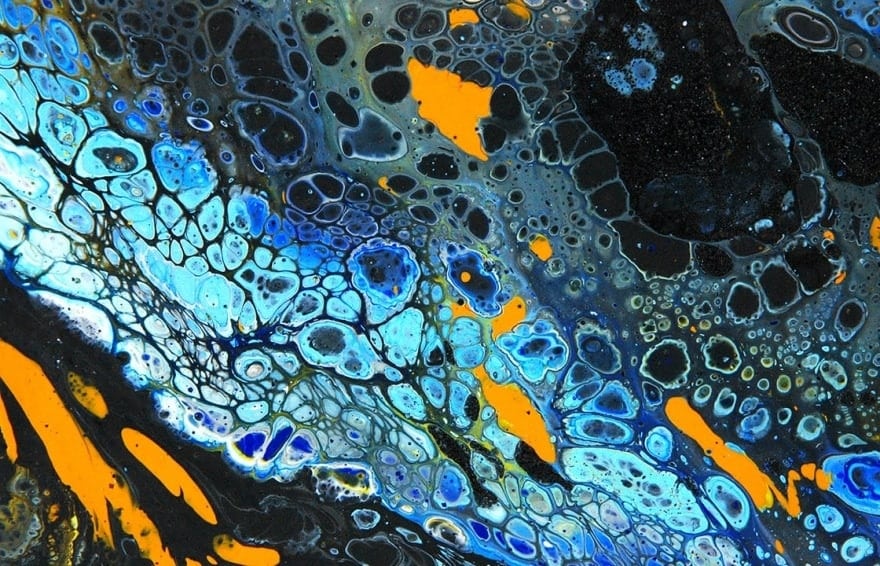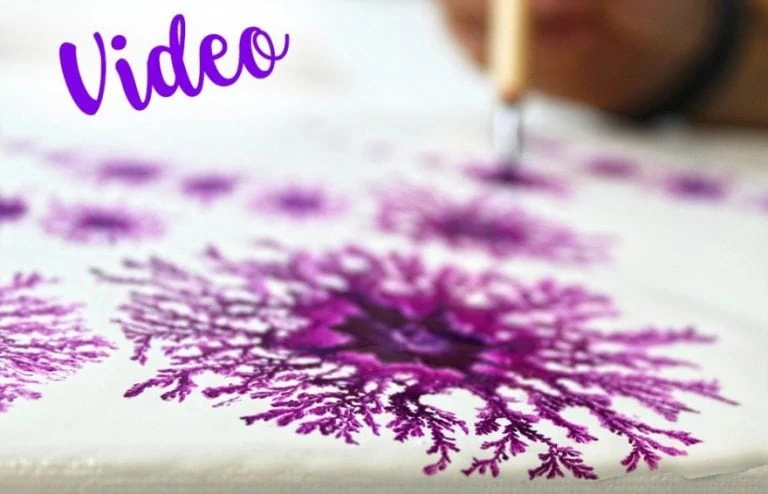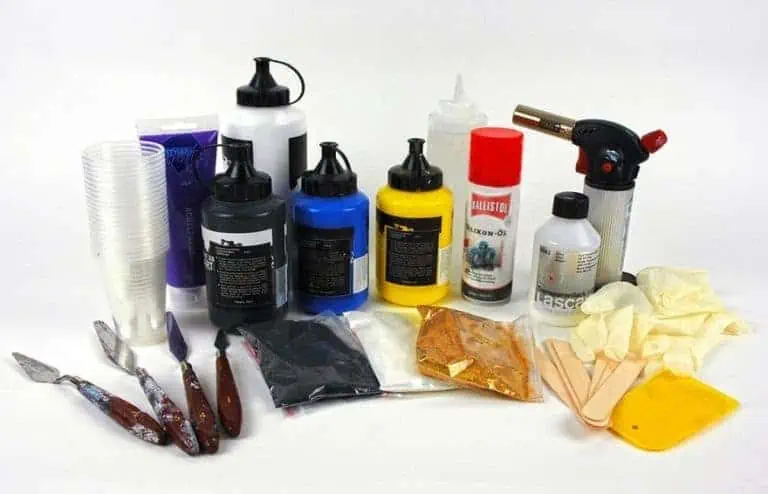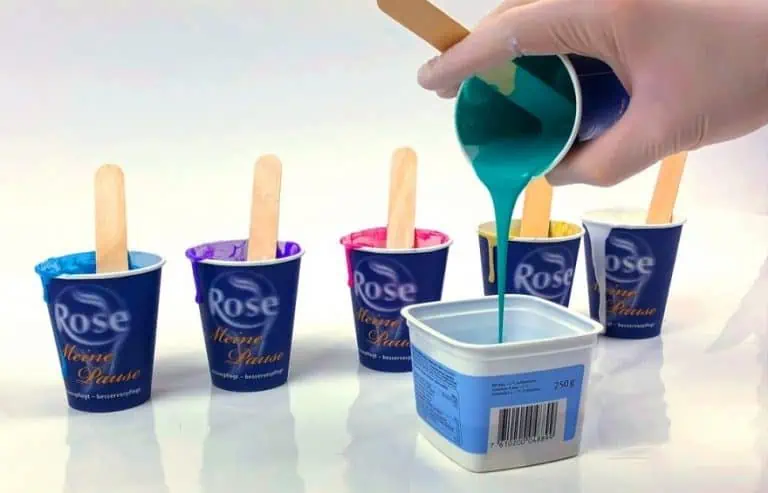The Secret to Acrylic Pouring Cells in your Fluid Paintings
This post may contain affiliate links. We may earn a small commission from purchases made through them, at no additional cost to you.
Acrylic pouring cells create fascinating patterns and effects in your Acrylic Pouring paintings. But how do you get cells to form reliably on your paintings? We have compiled our basic recipe and many other useful information on this subject in this article.
Table of Contents
How to achieve a lot of Acrylic Pouring Cells
The addition of silicone creates the desired acrylic pouring cells on your paintings created using the acrylic pouring technique. But with which silicon-containing product do you get the most cells or the largest cells?
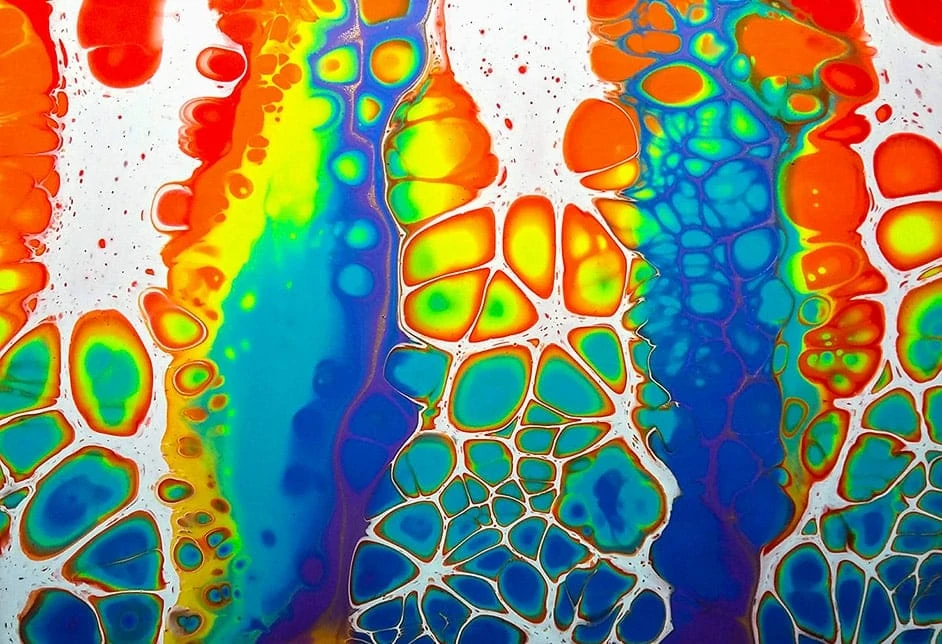
Silicone Oil
Silicone oil is not the same as silicone oil, there are significant differences in viscosity:
Low Viscosity:
- Produces large cells, some with additional cells in them
- Faster ink flow
- Stronger color gradients
High Viscosity:
- Produces smaller, sharply defined cells
- Slightly slower ink flow
- Rather fewer color gradients
- Results in smaller, sharply defined cells
We have achieved very good results with the following silicone oil:
Hair Oil with Dimethicone
Many artists have reported that very good results can be achieved with hair oil. It should be noted that in hair oil at the top of the list of ingredients “Dimethicone” is listed. Dimethicone is a silicone additive that is often used in cosmetic products.
We have achieved great results with the following hair oil, which is also used by many American pourers:
If you need further help for your Acrylic pourings, we recommend you to subscribe our free 3-part e-Mail course about Acrylic Pouring
The most important Factor: The right Pouring Medium
It is essential that you use a suitable pouring medium. You mix it with acrylic paint and a little water, depending on what you use. We have created an overview of all Pouring medium available on the market
If you are new to Acrylic Pouring and would like to make your first attempts, we recommend that you buy a Pouring Set consisting of Acrylic Paint and matching Pouring Medium. Here you don’t need any additional silicone, because everything is already included in this set. Simply mix acrylic paint and Pouring Medium and you can start with the Acrylic Pouring:
Consistency as Key to Success for Acrylic Pouring Cells
The key to success for many beautiful acrylic pouring cells is the consistency of your acrylic colors mixed with pouring medium. Only if this consistency fits, you will prevent the different colors from mixing too firmly and the cells from running (too liquid) and cells from forming at all (too thick). The consistency should remind you of more liquid honey, then you have a good conistency for your pouring.
As a basis you can use the following recipes:
- 1 part acrylic paint
- 1.5 Parts of pouring medium
- 1 part distilled water1
- 1 part acrylic paint
- 1.5 Parts of casting medium
- 0.5 Part of distilled water1 Teil Acrylfarbe
- 1 part acrylic paint
- 1.5 Parts of casting medium
- 0.5 Part of distilled water
We recommend that you first mix the paint very well with the Pouring Medium and then gradually add the water until the consistency is as described above.
Additives for safe Acrylic Pouring Cells Formation
Once you have mixed the colors and the consistency is as desired, you can add one or two drops of silicone or hair oil to each color (except white) and then stir again briefly. Then pour your picture with the desired technique. A subsequent application of silicone on the polished picture does not bring any more big change.
After the application of the paint, you go briefly with a hot air hairdryer or torch over the paint and then swivel your canvas until you like the result.
We have summarized the individual Fluid Painting techniques in our article “Acrylic Pouring techniques – How to fluid paint“.
Frequently asked questions about Pouring Medium
What is a Pouring Medium?
The liquid pouring medium can be mixed with any acrylic paint to produce smooth, uniform color films without increasing the transparency of the color. It also dries more slowly and without cracks.
Is it possible to make Pouring Medium yourself?
Yes, you can make your own pouring medium. Vinyl glue, which is mixed with some water and a few drops of silica oil if necessary, is suitable as a basis for this.
What is the mixing ratio for Pouring Medium?
This varies from product to product. Often the mixing ratio is 1 part color with 2 parts pouring medium. In addition, often some water is added to obtain a more liquid consistency.
In 2005, Charlene completed her wellness degrees in therapeutic aromatherapy and reflexology at the International School of Reflexology and Meridian Therapy. She worked for a company offering corporate wellness programs for several years before opening her own therapy practice. In 2015, she was asked by a digital marketer friend to join her company as a content creator, and it was here that she discovered her enthusiasm for writing. Since entering the world of content creation, she has gained a lot of experience over the years writing about various topics such as beauty, health, wellness, travel, crafting, and much more. Due to various circumstances, she had to give up her therapy practice and now works as a freelance writer. Since she is a very creative person and as a balance to writing likes to be active in various areas of art and crafts, the activity at acrylgiessen.com is perfect for her to contribute their knowledge and experience in various creative topics.
Learn more about Charlene Lewis and about us.
